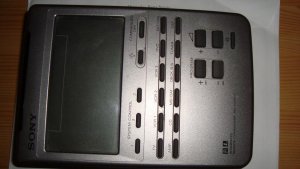Neida, det er ikke så veldig uffda, alt har sin tid. Sony hadde mange fantastiske produkter frem til inn på nittitallet, men så var det mer eller mindre over. Omstruktureringer, nye aktører og ny teknologi tok rotta på Sony.
Axel skriver bl.a. dette på The Vintage Knob:
Sony ES on thevintageknob.org
The first ES series became an instant hit : while Matsushita still had five tubed components, ditto Sansui, Kenwood a quartet of unrelated units and Pioneer still was an industry minor, Sony was selling its STR-6060, TA-1120, TA-3120A and TTS-3000 by the thousands and thousands - worldwide.
The second ES series, although never named as such, followed on that success : TA-1130, ST-5150, TC-755, SQD-2020, PS-2250, TTS-4000 etc all sold like hotcakes throughout the world.
The third ES series was known in Japan and somewhat in Germany as "ESII"
The name itself mainly pointed to a design difference but also makes a clear marker of when hi-fi truly became a market-for-the-masses : 1973/74.
This is when Yamaha launched its real NS series, when Kenwood came with the Supreme and the ATC Series and when all others augmented lineups to have them as plethoric as Sony had them since 1970.
Sony again sold oooooodles of components from the ESII lineups (TA-5650, ST-5950, PS-4750 etc) and managed to produce several all-time bests such as the TC-880-2 or SS-8150.
After that, 1976/77, the hi-fi market is running full-speed and a sort of quality segmentation appears.
The late ESII gives way to its gems (TA-F6B, TA-N7B, ST-A7B etc), sided by an unbelievably successful push toward "higher-end" (TA-E88B, TA-N86B etc - the pre-Esprit) and lineups getting really plethoric and often market-targeted.
From this stam the ESPRIT series, which took some of the mousse off the ES series.
ES, as a coherent set of components, got relegated to bit player while new technologies, smaller enclosures, new manufacturing technologies and the multiplication of flashy features made the news.
Paradoxically, this is when the second "official" ES logo appeared : 1979. It was however put on a component, the TC-K88B, directly descending from the pre-Esprit and accompanied by another logo, ESPRIT, something which that component wasn't either !
October 1982 is the rebirth of ES and the birth of it for us westerners : dedicated lineup, dedicated catalogs and the ES logo clearly, plainly, simply, silkscreened on the front plates. It took seventeen years but "ES" was at last palpable, visible and materialized !
This ES series, the fourth, sold extremely well as well, helped by the little sales boom which followed the introduction of CD (TA-F555ES, PS-X555ES, TC-K777ES, CDP-501ES etc) even if Sony managed to insert some incoherences in design and technologies.
The fifth ES series came to in 1986 and, again, sold like french croissants on a sunday morning. Worldwide, again : TA-F800ES, TC-K700ES, CDP-555ESD etc.
The sixth ES series is the one everybody remembers clearly : it holds the stream of X7 and X5 CD players, the flurry of F555ES amplifiers, the TA-E1000ESD or the well-remembered DAT recorders, all outselling all other brands until 1994.
With the seventh ES series, 1994, "series" became a somewhat overstated definition. Lineups were downsized to half a dozen units in all : high-fidelity sales had started to dwindle due to the bursting of the financial "bubble", upcoming home-theater on one side and the "QS" series Sony deemed interesting to flank ES with on the other. ES again was relegated to bit player.
This time, however, it was for good : after a few very successful home-theater-dedicated amps, preamps and receivers launched before the new millenium, the ES tag gradually vanished in the shadows of the new Internet-driven world.
The last ES "series" consisted of three components : SCD-501, TA-F501 and SS-K10ED. Made in Malaysia, China for the speakers, not particularily beautiful, well finished or well built, this last "501" was a clear but cheap retake of the successful Series 5000. It wasn't named ES and it didn't sell much.
The End.





